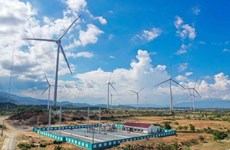Vietnam’s presence alters pepper market
India’s Financial Times carried an article on Dec. 28, saying that the dynamics
of the pepper trade have changed significantly over the last few years as
Vietnam entered the global market as a key producer.
India’s Financial Times carried an article on Dec. 28, saying that the dynamics
of the pepper trade have changed significantly over the last few years as
Vietnam entered the global market as a key producer.
The emergence of Vietnam as a leading producer has resulted in buyers shifting to short-term contracts and India transforming itself into a net importer of pepper. This has changed the global pepper trade irreversibly, said economic analyst Rajesh Ravi who wrote the article.
India used to export 40,000- 50,000 tonnes of pepper annually to top up its yearly production of 80,000-100,000 tonnes, according to the analyst.
However, production in India has dropped to 50,000 tonnes, while it remains the largest consumer of pepper in the world, with its annual domestic consumption estimated at 40,000-45,000 tonnes.
Meanwhile, Vietnam leads the global pepper trade, growing between 110,000-125,000 tonnes annually. It also leads in productivity, producing 1,200 kg to 1,300 kg per hectare.
Ravi noted that in the last two years, the Vietnamese Pepper Association (VPA) has held back a lot of its reserves so it can avoid flooding the market, which lowers prices.
The VPA has also invested in building more warehouses to sell in a systemised manner to take more advantage of the market.
The analyst forecasts that the number of contracts for 2010 may be lower than normal as the economic slow down and less available credit has made buyers opt for quicker contracts as they are living from hand to mouth.
Big retailers are not only keeping lower stocks, they are storing for shorter periods. This will lead to a volatile market in 2010 due to a mismatch of buying and selling needs, he wrote./.
The emergence of Vietnam as a leading producer has resulted in buyers shifting to short-term contracts and India transforming itself into a net importer of pepper. This has changed the global pepper trade irreversibly, said economic analyst Rajesh Ravi who wrote the article.
India used to export 40,000- 50,000 tonnes of pepper annually to top up its yearly production of 80,000-100,000 tonnes, according to the analyst.
However, production in India has dropped to 50,000 tonnes, while it remains the largest consumer of pepper in the world, with its annual domestic consumption estimated at 40,000-45,000 tonnes.
Meanwhile, Vietnam leads the global pepper trade, growing between 110,000-125,000 tonnes annually. It also leads in productivity, producing 1,200 kg to 1,300 kg per hectare.
Ravi noted that in the last two years, the Vietnamese Pepper Association (VPA) has held back a lot of its reserves so it can avoid flooding the market, which lowers prices.
The VPA has also invested in building more warehouses to sell in a systemised manner to take more advantage of the market.
The analyst forecasts that the number of contracts for 2010 may be lower than normal as the economic slow down and less available credit has made buyers opt for quicker contracts as they are living from hand to mouth.
Big retailers are not only keeping lower stocks, they are storing for shorter periods. This will lead to a volatile market in 2010 due to a mismatch of buying and selling needs, he wrote./.













